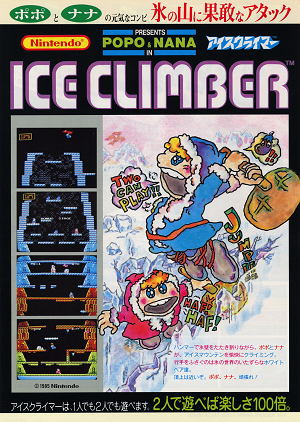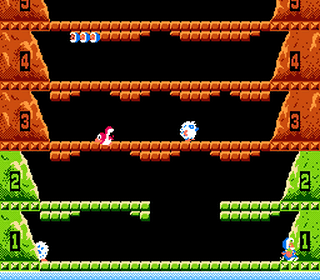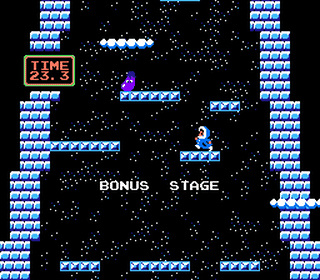Nice Climber Part 1
Ice Climber is a game that’s more interesting to talk about than to play. Too bad nobody cares about it enough to do either.

It’s a damn shame because there’s a lot to discuss, but in order to trick anyone into caring about this weird first-party Nintendo relic there’s one glaring setback that must be addressed first:
The game sucks to play.
Ice Climber’s art, sound, music, concept, & structure all hold up relatively well, but moving your little guy around onscreen is miserable. Ice Climber was the last platformer developed by Nintendo before Super Mario Bros., and it sure feels like it. Despite this, the game has managed to retain a nonzero level of relevance mostly thanks to protagonists Nana & Popo making several appearances in Smash Bros, which also serve as their only appearances since because there has never been a follow-up to the 1985 release. I have a soft spot for Ice Climber, and I think it’s about time somebody gave it the spit-shine it deserves. My goal with this project is to re-create Ice Climber from the ground up using only the art & sound assets from the original game. My focus is on improving character movement, collision, and game feel.
I feel like this is a perfect project to practice the fundamentals of making a game that feels good to play. The worst parts of Ice Climber are the details of the movement mechanics, so we're gonna have to get into the nitty-gritty details of real-time character control design.
The foundation of all 2D platformers is how it feels to simply control your character. After thirty-plus years of iteration on the “run & jump & maybe a third verb” formula & the torrent of 2D platformers in the indie space it’s easy to assume the challenge of making a 2D platformer that “feels good” is a solved problem. However, “good” game feel is not that simple.
This isn’t gonna be something where I just throw the movement system from Celeste onto the characters and call it a day. I want to improve the player’s movement mechanics and collision, but I want it to still feel like Ice Climber. I think a middle ground can be cobbled together here. Instead of changing the whole game on a fundamental level, the point of this project is accomplishing the game’s existing design goals using modern game design techniques. Let’s not throw the whole thing away; there’s a lot of bathwater but there’s gotta be a baby in here somewhere, right?
why it's bad
intertia
Ice Climber feels bad to play because it lacks inertia. I’ll get into more detail but the tl;dr is that the player character’s rigid states that fail to blend together to make up the bare minimum of all common-sense real-time character control design.
jumping
 Ice Climber’s jumping mechanics baffle me. If the jump button is pressed along with a horizontal direction, the player’s trajectory is set in stone regardless of any inputs they make midair. If the jump button is pressed without any horizontal directions, the player is able to slightly influence their trajectory only while descending. This gives us the worst of both worlds in which the jump behavior changes based on variables that the player is unlikely to be aware of. In a game that involves jumping as much as Ice Climber does, this has a massive negative impact on the player’s sense of control over their character, and is one of the primary failings holding the game back.
Ice Climber’s jumping mechanics baffle me. If the jump button is pressed along with a horizontal direction, the player’s trajectory is set in stone regardless of any inputs they make midair. If the jump button is pressed without any horizontal directions, the player is able to slightly influence their trajectory only while descending. This gives us the worst of both worlds in which the jump behavior changes based on variables that the player is unlikely to be aware of. In a game that involves jumping as much as Ice Climber does, this has a massive negative impact on the player’s sense of control over their character, and is one of the primary failings holding the game back.
Most 2D platformers give the player some level of control over their character’s jump arc midair. The exact amount of influence varies from game to game but in general the amount of influence a player has over their trajectory midair is a vital contributor to game feel. A game that gives the player a high level of control midair does so to encourage speed and make precision jumps easier to pull off.
Allowing the player to change their landing spot midair has a massive effect on the game’s pace. It shifts the time at which decisions must be made. If a jump arc is set the moment your thumb hits the button, the player is going to consider their trajectory and landing target entirely before pressing ‘jump’. This slows the game’s pace and encourages a deliberate, measured playstyle in which players are rewarded for looking before they leap. As loath as I am to quote Arin Hanson, I don’t think I can put it better than his description of Castlevania’s jumping controls as being such that “you have to buy a fuckin’ engagement ring for your jump arc.”
On the other hand, games that allow a high level of midair control encourage a faster, more “athletic” playstyle. This is especially true in games that use jumping as a method of dealing with enemies. If an enemy needs to be landed on in order to be defeated, a designer will probably want to allow the player to adjust their “aim” in between takeoff and landing. Mario, Zelda II, and Donkey Kong Country come to mind as examples of this ethos.
I want to stress that this is almost never a binary decision. It’s uncommon for games to give players no midair influence whatsoever (especially nowadays), just as it’s rare for midair movement to be as responsive as grounded movement even in high-pace platformers. The amount of influence that players have over their midair trajectory is a major contributor to how a game feels to play, especially when “Jump” is one of the player’s primary verbs.
In addition, the player character’s horizontal velocity has no impact whatsoever on any jump or fall. This means that a jump with a running start and a jump from a standstill result in the same jump trajectory. This one’s a lot more straightforward but I feel like it’s generally assumed as a part of movement in video games post-Super Mario Bros. Like even outside of platformers that’s just a fundamental part of modern real-time control of video game characters.
collision
 This one isn’t too complicated. Collision between the player and platforms they may try to land on is unreliable. Sometimes the player will simply phase through solid ground if they didn’t jump exactly the way the game wants them to. In my experience, any “close” jump I had resulted in my passing through the block I meant to land on.
This one isn’t too complicated. Collision between the player and platforms they may try to land on is unreliable. Sometimes the player will simply phase through solid ground if they didn’t jump exactly the way the game wants them to. In my experience, any “close” jump I had resulted in my passing through the block I meant to land on.
In a 2D platformer where progress is made via vertical movement and falling past the bottom of the screen kills you, it is a massive issue that any jump just short of 2 solid feet on the ground results in player frustration.
new & improved movement mechanics!
These two shortcomings (lack of fluid movement & poor collision detection) compound on each other to ruin the entire experience. I’ll get more in-depth about other problematic aspects of design in later posts, but fixing these two flaws causes a monumental improvement in the game’s feel.
The next post will be a detailed breakdown of the improvements, but to close this first blog post I wanted to provide a playable demo of the new, improved character controller. The hammer attack and sound effects aren't implemented yet but the important parts are there! Enjoy, and feel free to drop me a line on Bluesky @2sad4war.bsky.social if you have any thoughts!
Until next time,
-Jackson O.